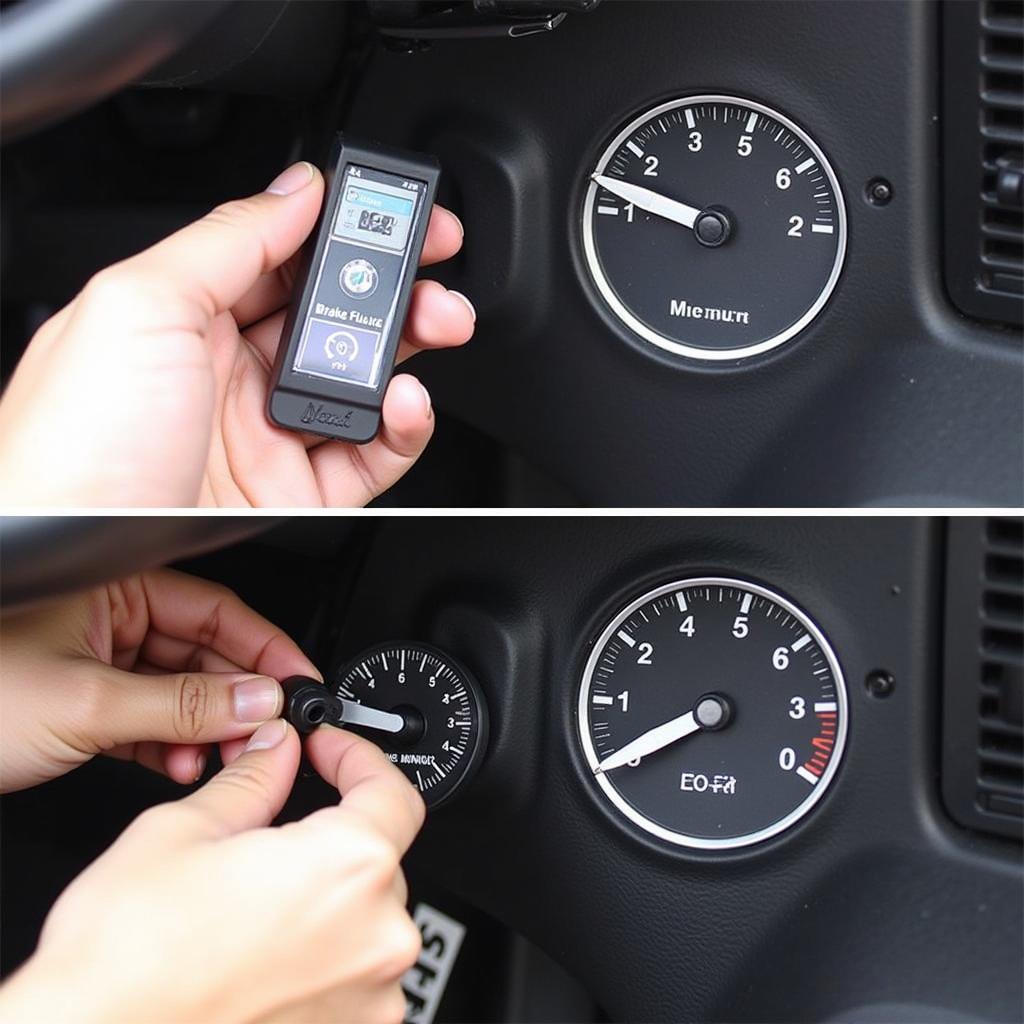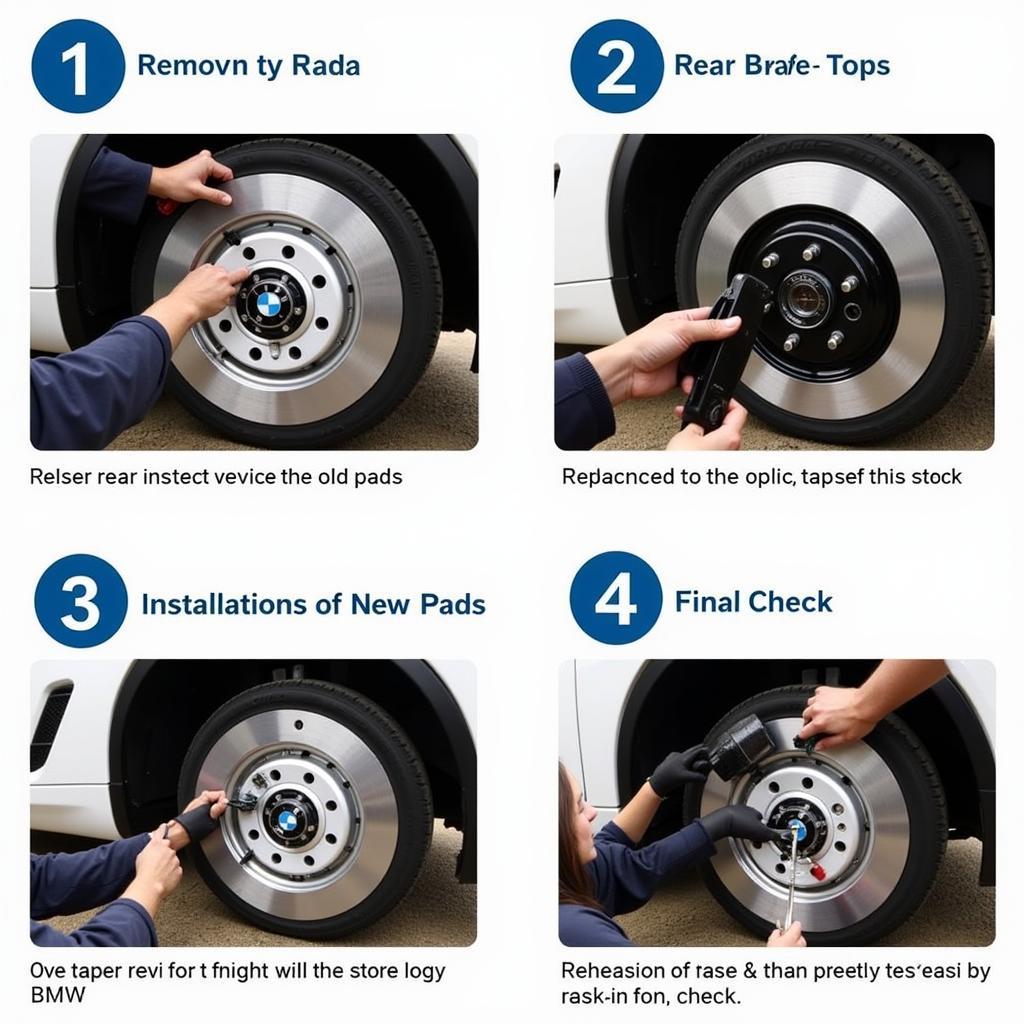The dreaded “brake” warning light illuminating on your BMW dashboard can trigger a wave of anxiety. But don’t panic! While it’s crucial to address any brake-related issues promptly, understanding the cause can help you navigate the situation calmly and safely. This article delves into the common reasons behind the “BMW rear brake pad warning light” and provides you with a guide on the next steps to take.
Decoding the Warning: Why is My BMW Rear Brake Pad Light On?
The rear brake pad warning light is your BMW’s way of communicating that the brake pads on your rear wheels have worn down to a critical level. This light is directly connected to a sensor embedded within the brake pad itself. Once the pad wears thin, the sensor triggers the warning light on your dashboard, signaling the need for replacement.
Let’s break down the potential culprits behind this illumination:
- Worn Brake Pads: The most common reason, as the name suggests, is the natural wear and tear of your rear brake pads. Over time, friction from braking gradually reduces the thickness of the pads.
- Worn Brake Sensors: Your BMW utilizes sensors that act as a “tripwire.” When the brake pad reaches a certain minimum thickness, the sensor makes contact, completing a circuit and illuminating the warning light.
- Faulty Brake Sensor: While less common, it’s possible for the sensor itself to malfunction. A damaged wire or a sensor dislodged from its position can trigger a false warning.
- Brake Fluid Leak: A leak in your brake fluid system can also cause the warning light to activate. Brake fluid is incompressible, meaning it plays a vital role in transferring force when you press the brake pedal. A leak can compromise braking performance significantly.
What to Do When Your BMW Rear Brake Pad Warning Light Turns On
Ignoring a brake warning light is like ignoring a flashing “danger” sign – extremely risky. Here’s a step-by-step guide on what actions to take:
- Assess Your Driving Conditions: If you’re on a busy highway or in traffic, prioritize safety. Carefully maneuver your vehicle to a safe location, away from oncoming traffic.
- Check Your Brake Fluid Level: Park your car on a level surface, engage the parking brake, and locate the brake fluid reservoir under the hood. The reservoir will have markings indicating the minimum and maximum levels. If the fluid level is significantly low or below the minimum mark, it indicates a potential leak.
- Avoid Driving (If Possible): Driving with severely worn brake pads or a brake fluid leak is extremely dangerous. If you suspect either of these issues, it’s best to have your BMW towed to a qualified mechanic or a BMW dealership.
- Schedule an Inspection: Even if your brake fluid level seems normal, it’s essential to schedule an inspection with a qualified mechanic specialized in BMWs. They can thoroughly inspect your brakes, determine the root cause of the warning light, and recommend the necessary repairs.
 Checking BMW Brake Fluid Level
Checking BMW Brake Fluid Level
The Importance of Addressing Brake Issues Immediately
Your BMW’s braking system is your lifeline on the road. Ignoring a brake warning light can lead to:
- Reduced Braking Power: Worn brake pads compromise your BMW’s ability to stop effectively, significantly increasing your stopping distance.
- Rotor Damage: Driving with worn brake pads can cause the metal backing plate of the pad to rub against the brake rotor, leading to costly rotor replacement.
- Brake Failure: In extreme cases, neglecting brake issues can result in complete brake failure, putting your safety and the safety of others at severe risk.
BMW Rear Brake Pad Replacement: What to Expect
During a brake pad replacement, a qualified mechanic will typically:
- Inspect the Entire Brake System: This includes checking the brake pads, rotors, calipers, brake lines, and fluid levels for any signs of wear, damage, or leaks.
- Replace the Brake Pads: Worn-out rear brake pads will be replaced with new ones compatible with your specific BMW model.
- Resurface or Replace the Rotors (If Necessary): If your rotors show signs of wear, such as grooves or scoring, they may need to be resurfaced or replaced.
- Replace the Brake Sensors: It’s standard practice to replace the brake pad wear sensors along with the brake pads.
- Bleed the Brake System: This procedure involves removing any air bubbles from the brake lines to ensure optimal braking performance.
 BMW Rear Brake Pad Replacement
BMW Rear Brake Pad Replacement
Expert Insight:
“Don’t underestimate the importance of regular brake inspections,” advises Mark Stevenson, a seasoned BMW technician with over 15 years of experience. “Many factors, including driving habits and environmental conditions, can impact brake wear. Catching potential issues early can save you from costly repairs and ensure your safety on the road.”
Preventing Future Issues: Tips for Prolonging Brake Pad Life
- Smooth Braking: Avoid harsh braking whenever possible. Gradual braking reduces wear and tear on your brake pads and rotors.
- Anticipate Stops: Look ahead while driving and anticipate stops. This allows you to coast to a stop gently, minimizing brake usage.
- Lighten the Load: Carrying excessive weight in your BMW puts added stress on your braking system. Travel light whenever possible.
- Regular Maintenance: Adhere to your BMW’s recommended maintenance schedule, which includes regular brake inspections and fluid flushes.
Conclusion
The “BMW rear brake pad warning light” is a crucial safety feature designed to alert you of potential braking issues. Addressing this warning promptly is paramount to ensure your safety and prevent further damage to your vehicle. By understanding the causes, taking appropriate actions, and practicing proactive maintenance, you can enjoy many miles of confident and worry-free driving in your BMW.
FAQ
Q: Can I drive my BMW with the rear brake pad warning light on?
A: While you might be able to drive a short distance, it’s highly discouraged. Driving with worn brake pads compromises your safety and can lead to further damage. Seek immediate inspection and repair.
Q: How much does it cost to replace BMW rear brake pads?
A: The cost can vary based on your BMW model, labor rates, and whether additional repairs are needed. It’s best to contact a qualified mechanic or a BMW dealership for a precise quote.
Q: How often should I replace my BMW’s brake pads?
A: Brake pad lifespan depends on driving habits and conditions. However, it’s generally recommended to have them inspected every 15,000 miles and replaced as needed.
Q: Can I replace my BMW brake pads myself?
A: While possible, it’s recommended to leave brake repairs to qualified professionals. Brakes are a critical safety system requiring specialized tools and expertise.
Q: What’s the difference between the “brake” warning light and the “ABS” warning light?
A: The “brake” warning light indicates an issue with your primary braking system, while the “ABS” light signals a problem with the Anti-lock Braking System. Both warrant immediate attention from a qualified mechanic.
Remember, when it comes to your BMW’s brakes, erring on the side of caution is always the safest approach.
